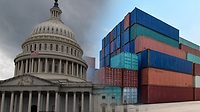Economic Uncertainty Deepens as Tariffs Rise, Recession Debate Grows

Web-GI-1348973815-1170x658
Recent economic developments have introduced significant uncertainties that could impact various industries, including the paint and coatings sector.
Escalation of Tariffs
President Donald Trump announced plans to double tariffs on Canadian steel and aluminum imports to 50%, citing Ontario's electricity price hikes as the catalyst for this decision. This escalation has led to notable declines in major U.S. stock indices, including the S&P 500 and Dow Jones Industrial Average.
Mixed Signals on Economic Outlook
In a recent interview, President Donald Trump did not rule out the possibility of a recession resulting from his trade tariffs policy, but emphasized that any economic downturn would be part of a transitional period aimed at achieving long-term economic goals and bringing wealth back to America. He downplayed recent stock market volatility linked to his tariff policy.
However, Treasury Secretary Scott Bessent described the situation as a "detox period" from government spending, which he believes is necessary for economic adjustment, suggesting that the administration does not anticipate a recession.
Corporate Caution Amid Uncertainty
Reflecting these uncertainties, Delta Air Lines has revised its first-quarter earnings and revenue outlook downward, citing reduced consumer and corporate confidence driven by economic uncertainty. Domestic demand is weakening, though growth trends in premium, international and loyalty revenue remain as expected. While Delta is not a coatings company, its experience underscores the broader impact of economic uncertainty on various sectors.
Implications for the Paint and Coatings Industry
These developments could have several implications for the paint and coatings industry:
- Higher Raw Material Costs: Increased tariffs on imported materials may lead to higher costs for raw materials essential to paint and coatings production.
- Supply Chain Delays: Trade tensions and potential government shutdowns could disrupt supply chains, causing delays in obtaining necessary components.
- Increased Costs to End Users: Manufacturers might pass on higher production costs to consumers, potentially reducing demand.
Given these uncertainties, it is expected that companies in the paint and coatings sector will closely monitor policy changes and economic indicators to adapt their strategies accordingly.
For a deeper look at how these economic shifts could disrupt the paint and coatings supply chain, including material costs and logistics challenges, read additional coverage here.
Looking for a reprint of this article?
From high-res PDFs to custom plaques, order your copy today!







